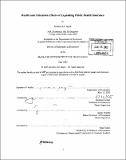| dc.contributor.advisor | Jonathan Gruber and James Poterba. | en_US |
| dc.contributor.author | Boyle, Melissa Ann | en_US |
| dc.contributor.other | Massachusetts Institute of Technology. Dept. of Economics. | en_US |
| dc.date.accessioned | 2006-03-29T18:42:10Z | |
| dc.date.available | 2006-03-29T18:42:10Z | |
| dc.date.copyright | 2005 | en_US |
| dc.date.issued | 2005 | en_US |
| dc.identifier.uri | http://hdl.handle.net/1721.1/32410 | |
| dc.description | Thesis (Ph. D.)--Massachusetts Institute of Technology, Dept. of Economics, 2005. | en_US |
| dc.description | Includes bibliographical references. | en_US |
| dc.description.abstract | This thesis exploits a major overhaul in the U.S. Department of Veterans Affairs health care system to answer various questions about publicly-provided health care. The VA restructuring involved the adoption of a capitated payment system and treatment methods based on the managed care model. This reorganization was accompanied by a major expansion in the population eligible to receive VA care. Chapter one analyzes both the efficiency of providing public health care in a managed care setting and the effectiveness of expanding coverage to healthier and wealthier populations. I estimate that between 35 and 70 percent of new take-up of VA care was the result of individuals dropping private health insurance. While utilization of services increased, estimates indicate that the policy change did not result in net health improvements. Regions providing more care to healthier, newly-eligible veterans experienced bigger reductions in hospital care and larger increases in outpatient services for previously-eligible veterans. This shift away from specialty care may help to explain the aggregate health declines. Chapter two examines the impact of the introduction of a VA-sponsored drug benefit on Medicare-eligible veterans. Results suggest that a drug benefit does not result in changes in the quantity of drugs consumed, but does lead to an increase in spending and a shift in who pays for the prescriptions. The benefit appears to have a larger effect on lower-income individuals. Results also show suggestive evidence of positive health effects as a result of the drug benefit, an outcome which could be cost-saving in the long run. | en_US |
| dc.description.abstract | (cont.) Chapter three utilizes the change in government health care coverage for veterans to test whether employer-provided insurance leads to inefficiencies in the labor market, and the degree to which such inefficiencies might be alleviated by expanding public health insurance programs. We examine the impact of health care coverage on labor force participation and retirement by comparing veterans and non-veterans before and after the VA expansion. Results indicate that workers are significantly more likely to cease working as a result of becoming eligible for public insurance, and are also more likely to move to part-time work. | en_US |
| dc.description.statementofresponsibility | by Melissa Ann Boyle. | en_US |
| dc.format.extent | 118 p. | en_US |
| dc.format.extent | 5902237 bytes | |
| dc.format.extent | 5909569 bytes | |
| dc.format.mimetype | application/pdf | |
| dc.format.mimetype | application/pdf | |
| dc.language.iso | eng | en_US |
| dc.publisher | Massachusetts Institute of Technology | en_US |
| dc.rights | M.I.T. theses are protected by copyright. They may be viewed from this source for any purpose, but reproduction or distribution in any format is prohibited without written permission. See provided URL for inquiries about permission. | en_US |
| dc.rights.uri | http://dspace.mit.edu/handle/1721.1/7582 | |
| dc.subject | Economics. | en_US |
| dc.title | Health and utilization effects of expanding public health insurance | en_US |
| dc.type | Thesis | en_US |
| dc.description.degree | Ph.D. | en_US |
| dc.contributor.department | Massachusetts Institute of Technology. Department of Economics | |
| dc.identifier.oclc | 61696355 | en_US |
